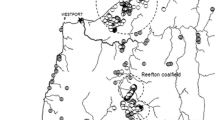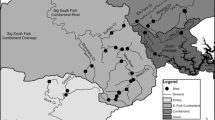Abstract
There have been contradictory reports of the relative proportion of mercury from coal-fired power plants that deposits locally. Our objective was to determine any local effect of coal-fired power plants on total mercury concentrations in wetland sediment and tadpole samples. Four power plants and 45 wetlands were selected for study. Total mercury concentrations were determined in 75 sediment samples (range: 8–82 ng/g dry weight) and 100 bullfrog (Lithobates catesbeiana) and green frog (Lithobates clamitans) tadpoles (range: 5–318 ng/g wet weight). Tadpole and sediment total mercury did not significantly vary by power plant or distance from the plant. Only one power plant had a significantly greater concentration of total mercury in sediment downwind compared to upwind wetlands. A similar (but non-significant) trend was found for tadpole total mercury surrounding the same plant. Tadpole total mercury was negatively correlated with both tadpole weight and total length. Tadpole and sediment total mercury concentrations were not significantly correlated with one another. The results of the current study suggest that coal-fired power plants are not significantly affecting mercury concentrations in surrounding wetlands.




Similar content being viewed by others
References
Altig R (1989) Guilds of anuran larvae: relationships among developmental modes, morphologies, and habitats. Herpetological Monographs 3:81–109
Altig R, Whiles MR, Taylor CL (2007) What do tadpoles really eat? Assessing the trophic status of an understudied and imperiled group of consumers in freshwater habitats. Freshw Biol 52:386–395
Anderson WL, Smith KE (1977) Dynamics of mercury at coal-fired power plant and adjacent cooling lake. Environ Sci Technol 11:75–80
Bank MS, Loftin CS, Jung RE (2005) Mercury bioaccumulation in northern two-lined salamanders from streams in northeastern United States. Ecotoxicology 14:181–191
Bank MS, Crocker J, Connery B, Amirbahman A (2007) Mercury bioaccumulation in green frog (Rana clamitans) and bullfrog (Rana catesbeiana) tadpoles from Acadia National Park, Maine, USA. Environ Toxicol Chem 26:118–125
Berman M, Bartha R (1986) Control of the methylation process in a mercury-polluted aquatic sediment. Environ Pollut Ser B 11:41–53
Birge WJ, Black JA, Westerman AG, Hudson JE (1979) The effects of mercury on reproduction of fish and amphibians. In: Nriagu JO (ed) The biogeochemistry of mercury in the environment. Elsevier/North Holland Biomedical Press, Amsterdam, pp 629–655
Boening DW (2000) Ecological effects, transport, and fate of mercury: a general review. Chemosphere 40:1335–1351
Burger J, Snodgrass J (2001) Metal levels in southern leopard frogs from the Savannah river site: location and body compartment effects. Environ Res 86:157–166
Chang LW, Reuhl KR, Dudley AW Jr (1974) Effects of methylmercury chloride on Rana pipiens tadpoles. Environ Res 8:82–91
Clark DR Jr, Cantu R, Cowman DF, Maxson DJ (1998) Uptake of arsenic and metals by tadpoles at an historically contaminated Texas site. Ecotoxicology 7:61–67
Compeau G, Bartha R (1985) Methylation and demethylation of mercury under controlled redox, pH, and salinity conditions. Appl Environ Microbiol 48:1203–1207
Cooper CM, Gillespie WB Jr (2001) Arsenic and mercury concentrations in major landscape components of an intensively cultivated watershed. Environ Pollut 111:67–74
Crockett AB, Kinnison RR (1979) Mercury residues in soil around a large coal-fired power plant. Environ Sci Technol 13:712–715
Dastoor AP, Larocque Y (2004) Global circulation of atmospheric mercury: a modelling study. Atmos Environ 38:147–161
Davis A, Bloom NS, Hee SSQ (1997) The environmental geochemistry and bioaccessibility of mercury in soils and sediments: a review. Risk Anal 17:557–569
De Zwart D, Sloof W (1987) Toxicity of mixtures of heavy metals and petrochemicals to Xenopus laevis. Bull Environ Contam Toxicol 38:345–351
Dreher GB, Follmer LR (2004) Mercury content of Illinois soils. Water Air Soil Pollut 156:299–315
Du Laing G, Rinkelbe J, Vandecasteele B, Meers E, Tack FMG (2009) Trace metal behavior in estuarine and riverine floodplain soils and sediments: a review. Sci Total Environ 407:3972–3985
Duarte AC, Pereira ME, Oliveira JP, Hall A (1991) Mercury desorption from contaminanted sediments. Water Air Soil Pollut 56:77–82
Fitzgerald WF, Engstrom DR, Mason RP, Nater EA (1998) The case for atmospheric mercury contamination in remote areas. Environ Sci Technol 32:1–7
Gerstenberger S, Pearson R (2002) Mercury concentrations in bullfrogs (Rana catesbeiana) collected from a Southern Nevada, USA, wetland. Bull Environ Contam Toxicol 69:210–218
Gosner KL (1960) A simplified table for staging anuran embryos and larvae with notes on identification. Herpetologica 16:183–190
Goutner V, Furness RW (1997) Mercury in feathers of little egret Egretta garzetta and night heron Nycticorax nycticorax chicks and in their prey in the Axios delta, Greece. Arch Environ Contam Toxicol 32:211–216
He T, Lu J, Yang F, Feng X (2007) Horizontal and vertical variability of mercury species in pore water and sediments in small lakes in Ontario. Sci Total Environ 386:53–64
Health Canada (2007) Human health risk assessment of mercury in fish and health benefits of fish consumption. Bureau of Chemical Safety, Ottawa, Ontario. Available via Health Canada. http://www.hc-sc.gc.ca/fn-an/alt_formats/hpfb-dgpsa/pdf/nutrition/merc_fish_poisson-eng.pdf. Accessed 4 Nov 2008
Hintelmann H, Wilken R-D (1995) Levels of total mercury and methylmercury compounds in sediments of the polluted Elbe river: influence of seasonally and spatially varying environmental factors. Sci Total Environ 166:1–10
Hudson RJM, Gherini SA, Watras CJ, Porcella DB (1994) Modeling the biogeochemical cycle of mercury in lakes: the mercury cycling model (MCM) and its application to the MTL study lakes. In: Watras CJ, Huckabee JW (eds) Mercury pollution—integration and synthesis. Lewis Publishers, Boca Raton, FL, pp 473–523
Huggett DB, Stevens JA, Allgood JC, Lutken CB, Grace CA, Benson WH (2001) Mercury in sediment and fish from north Mississippi lakes. Chemosphere 42:923–929
Keeler GJ, Landis MS, Norris GA, Christianson EM, Dvonch JT (2006) Sources of mercury wet deposition in eastern Ohio. Environ Sci Technol 40:5874–5881
Khangarot BS, Ray PK (1987) Sensitivity of toad tadpoles, Bufo melanostictus (Schneider), to heavy metals. Bull Environ Contam Toxicol 38:523–527
Khangarot BS, Sehgal A, Bhasin MK (1985) “Man and Biosphere”-studies on the sikkim Himalayas. Part 5: acute toxicity of selected heavy metals on the tadpoles of Rana hexadactyla. Acta Hydrochimica et Hydrobiologia 13:259–263
Lin C, Pongprueksa P, Lindberg SE, Pehkonen SO, Byun D, Jang C (2006) Scientific uncertainties in atmospheric mercury models I: model science evaluation. Atmos Environ 40:2911–2928
MacDonald DD, Ingersoll CG, Berger TA (2000) Development and evaluation of consensus-based sediment quality guidelines for freshwater ecosystems. Arch Environ Contam Toxicol 39:20–31
Menounou N, Presley BJ (2003) Mercury and other trace elements in sediment cores from central Texas lakes. Arch Environ Contam Toxicol 45:11–29
National Climatic Data Center (1998) Climatic wind data for the United States. National Oceanic and Atmospheric Association, Washington, DC. Available via NCDC. http://www.ncdc.noaa.gov/oa/mpp/wind1996.pdf. Accessed 20 Nov 2006
Nichols JW (1997) Mercury study report to congress volume VI: an ecological assessment for anthropogenic mercury emissions in the United States. EPA-425/R-97-008. Final report. US Environmental Protection Agency, Washington, DC
Pinkney AE, Logan DT, Wilson HT (1997) Mercury concentrations in pond fish in relation to a coal-fired power plant. Arch Environ Contam Toxicol 33:222–229
Rinklebe J, During A, Oversech M, Wennrich R, Stark H-J, Mothes S, Neue H-U (2009) Optimization of a simple field to determine mercury volatilization from soils-examples of 13 sites in floodplain ecosystems at the Elbe river (Germany). Ecol Eng 35:319–328
Seigneur C, Lohman K, Vijayaraghavan K, Shia R-L (2003) Contributions of global and regional sources to mercury deposition in New York state. Environ Pollut 123:365–373
Smith PN, Cobb GP, Godard-Codding C, Hoff D, McMurry ST, Rainwater TR, Reynolds KD (2007) Contaminant exposure in terrestrial vertebrates. Environ Pollut 150:41–64
Sorensen JA, Glass GE, Schmidt KW, Huber JK, Rapp GR Jr (1990) Airborne mercury deposition and watershed characteristics in relation to mercury concentrations in water, sediments, plankton, and fish of eighty north Minnesota lakes. Environ Sci Technol 24:1716–1727
St. Louis VL, Rudd JWM, Kelly CA, Beaty KG, Bloom NS, Flett RJ (1994) Importance of wetlands as sources of methyl mercury to boreal forest ecosystems. Can J Fish Aquat Sci 51:1065–1076
Ullrich SM, Tanton TW, Abdrashitova SA (2001) Mercury in the aquatic environment: a review of factors affecting methylation. Crit Rev Environ Sci Technol 31:241–293
Unrine JM, Jagoe CH, Hopkins WA, Brant HA (2004) Adverse effects of ecologically relevant dietary mercury exposure in southern leopard frogs (Rana sphenocephala) larvae. Environ Toxicol Chem 23:2964–2970
Unrine JM, Jagoe CH, Brinton AC, Brant HA, Garvin NT (2005) Dietary mercury exposure and bioaccumulation in amphibian larvae inhabiting Carolina bay wetlands. Environ Pollut 135:245–253
Unrine JM, Hopkins WA, Romanek CS, Jackson BP (2007) Bioaccumulation of trace elements in omnivorous amphibian larvae: implications for amphibian health and contaminant transport. Environ Pollut 149:182–192
USEPA (2005) Method 245.7 mercury in water by cold vapor atomic fluorescence spectroscopy: revision 2.0. EPA-821-R-05-001. Technical report. US Environmental Protection Agency, Washington, DC
USEPA (2007) Method 3051A microwave assisted acid digestion of sediments, sludges, soils, and oils: revision 1. Technical report. US Environmental Protection Agency, Washington, DC
USEPA (2008) Toxics release inventory program. US Environmental Protection Agency, Washington, DC. Available via EPA. http://www.epa.gov/triexplorer/. Accessed 12 Sept 2008
USFWS (2009) National wetlands inventory. US Fish and Wildlife Service, Washington, DC. Available via FWS. http://www.fws.gov/wetlands/Data/Mapper.html. Accessed 15 Feb 2007
Vogel WR, Chovanec A (1992) Sediment analysis as a method of monitoring industrial emissions. Hydrobiologia 235(236):723–730
Wangen LE, Williams MD (1978) Elemental deposition downwind of a coal-fired power plant. Water Air Soil Pollut 10:33–44
Wolfe MF, Schwarzbach S, Sulaiman RA (1998) Effects of mercury on wildlife: a comprehensive review. Environ Toxicol Chem 17:146–160
Zillioux EJ, Porcella DB, Benoit JM (1993) Mercury cycling and effects in freshwater wetland ecosystems. Environ Toxicol Chem 12:2245–2264
Acknowledgments
This project was funded by the Illinois Sustainable Technology Center (#HWR06199). We would like to thank Gary Bordson, Brent Panno, and the rest of the metals group at the Illinois Sustainable Technology Center for their assistance in sediment mercury analysis. We wish to thank Matt Whiles for input regarding initial methods, and Tricia Trimble and Dawn Fallacara for laboratory assistance.
Author information
Authors and Affiliations
Corresponding author
Rights and permissions
About this article
Cite this article
Weir, S.M., Halbrook, R.S. & Sparling, D.W. Mercury concentrations in wetlands associated with coal-fired power plants. Ecotoxicology 19, 306–316 (2010). https://doi.org/10.1007/s10646-009-0413-3
Received:
Accepted:
Published:
Issue Date:
DOI: https://doi.org/10.1007/s10646-009-0413-3




